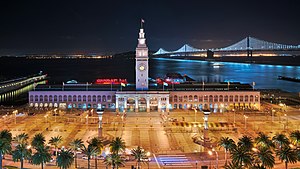
Back Infrastruktuur Afrikaans መሠረተ ልማት Amharic بنية تحتية Arabic Infraestructura AST İnfrastruktur Azerbaijani Impraestruktura BCL Інфраструктура Byelorussian Інфраструктура BE-X-OLD Инфраструктура Bulgarian इंफ्रास्ट्रक्चर Bihari

Infrastructure is the set of facilities and systems that serve a country, city, or other area,[1] and encompasses the services and facilities necessary for its economy, households and firms to function.[2] Infrastructure is composed of public and private physical structures such as roads, railways, bridges, airports, public transit systems, tunnels, water supply, sewers, electrical grids, and telecommunications (including Internet connectivity and broadband access). In general, infrastructure has been defined as "the physical components of interrelated systems providing commodities and services essential to enable, sustain, or enhance societal living conditions" and maintain the surrounding environment.[3]
Especially in light of the massive societal transformations needed to mitigate and adapt to climate change, contemporary infrastructure conversations frequently focus on sustainable development and green infrastructure. Acknowledging this importance, the international community has created policy focused on sustainable infrastructure through the Sustainable Development Goals, especially Sustainable Development Goal 9 "Industry, Innovation and Infrastructure".
One way to describe different types of infrastructure is to classify them as two distinct kinds: hard infrastructure and soft infrastructure.[4] Hard infrastructure is the physical networks necessary for the functioning of a modern industrial society or industry.[5] This includes roads, bridges, and railways. Soft infrastructure is all the institutions that maintain the economic, health, social, environmental, and cultural standards of a country.[5] This includes educational programs, official statistics, parks and recreational facilities, law enforcement agencies, and emergency services.
- ^ Infrastructure | Define Infrastructure at Dictionary.com Archived 2016-03-05 at the Wayback Machine
- ^ O'Sullivan, Arthur; Sheffrin, Steven M. (2003). Economics: Principles in Action. Upper Saddle River, NJ: Pearson Prentice Hall. p. 474. ISBN 978-0-13-063085-8.
- ^ Fulmer, Jeffrey (2009). "What in the world is infrastructure?". PEI Infrastructure Investor (July/August): 30–32.
- ^ Dyer, Mark; Dyer, Rachel; Weng, Min-Hsien; Wu, Shaoqun; Grey, Thomas; Gleeson, Richard; Ferrari, Tomás García (December 2019). "Framework for soft and hard city infrastructures". Proceedings of the Institution of Civil Engineers - Urban Design and Planning. 172 (6): 219–227. doi:10.1680/jurdp.19.00021. hdl:10289/15706. S2CID 209056612.
- ^ a b Hamutak, Luta. "Civil Society Comments on Infrastructure Strategic Sector" (PDF).
